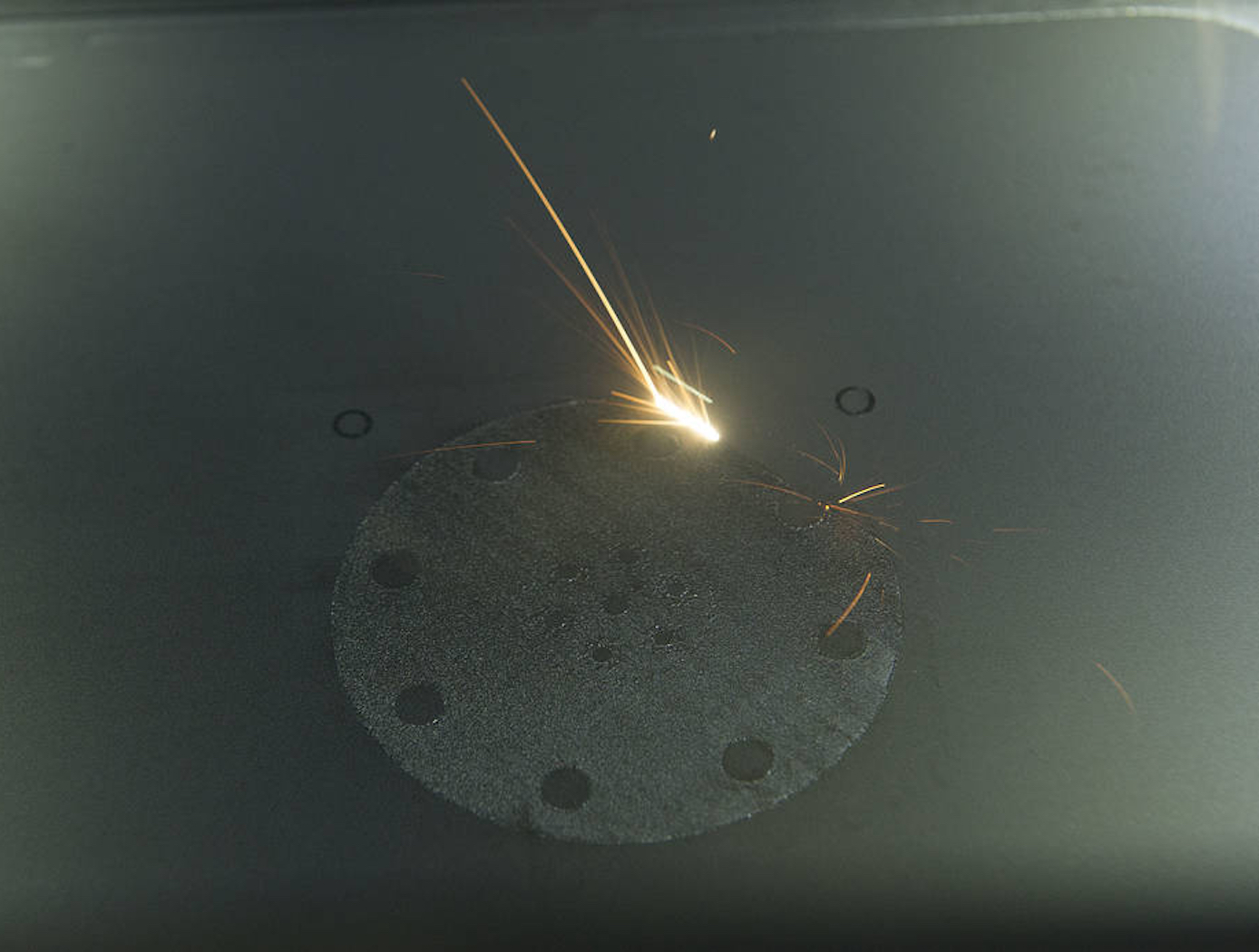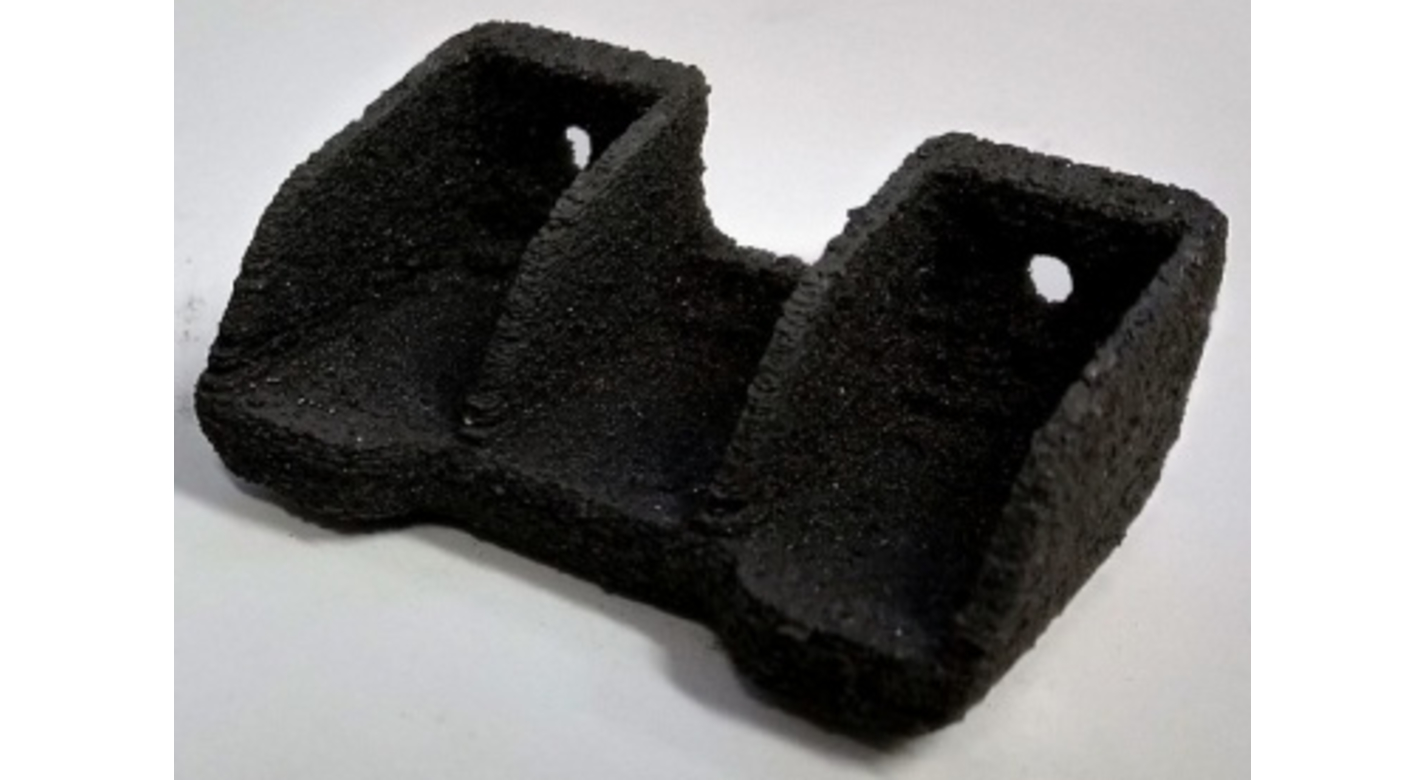3D-Printed Composites for High Temperature Uses
materials and coatings
3D-Printed Composites for High Temperature Uses (LEW-TOPS-145)
Using Laser Sintering to Manufacture Thermoset Polyimide Composites
Overview
Innovators at the NASA Glenn Research Center, in collaboration with the University of Louisville and the U.S. Air Force, have developed an additive manufacturing technique to produce composite parts with high-temperature capabilities using thermoset polyimide resins. The process uses selective laser sintering (SLS) to melt-process a powdered version of NASA's novel RTM370 imide resin filled with finely milled carbon fibers. The resulting composite part can be subsequently post-cured to prepare for high temperature aerospace applications, offering a 3D-printed composite part that can withstand temperatures over 300 °C. This is a significant advancement in the state-of-the-art in additive manufacturing polymers, offering an SLS process that requires relatively low melting temperatures and creates composites with high temperature capabilities, enabling 3D-printing of parts with complex geometry for high performance applications.
The Technology
NASA's technology is the first successful 3D-printing of high temperature carbon fiber filled thermoset polyimide composites. Selective Laser Sintering (SLS) of carbon-filled RTM370 is followed by post-curing to achieve higher temperature capability, resulting in a composite part with a glass transition temperature of 370 °C.
SLS typically uses thermoplastic polymeric powders and the resultant parts have a useful temperature range of 150-185 °C, while often being weaker compared to traditionally processed materials. Recently, higher temperature thermoplastics have been manufactured into 3D parts by high temperature SLS that requires a melting temperature of 380 °C, but the usable temperature range for these parts is still under 200 °C.
NASA's thermoset polyimide composites are melt-processable between 150-240 °C, allowing the use of regular SLS machines. The resultant parts are subsequently post-cured using multi-step cycles that slowly heat the material to slightly below its glass transition temperature, while avoiding dimensional change during the process. This invention will greatly benefit aerospace companies in the production of parts with complex geometry for engine components requiring over 300 °C applications, while having a wealth of other potential applications including, but not limited to, printing legacy parts for military aircraft and producing components for high performance electric cars.


Benefits
- High-temperature capability: NASA's thermoset polyimide composites retain mechanical properties at extremely high temperatures (over 300 °C)
- Simple production of high-performance, complex 3D parts: Objects with complicated structures that require high temperature applications can be 3D-printed by a regular SLS machine
- Lightweight components: Parts made from RTM370 composites are 30 percent lighter than metallic parts
- Clean and green: RTM370 uses a solvent-free production process that does not produce any harmful, volatile compounds
- Excellent impact-resistance and char yield: RTM370 composites demonstrate high impact resistance and outstanding abrasion resistance at ambient and high temperatures
Applications
- Aerospace
- Automotive
- Commercial space
- Construction
- Electronics
- Industrial machinery
- Marine
- Mechanical systems
- Oil and gas
Technology Details
materials and coatings
LEW-TOPS-145
LEW-19873-1
LEW-17618-1
"Laser Sintering of Thermoset Polyimide Composites," Kathy C. Chuang, et al., September 23, 2019,
https://ntrs.nasa.gov/search.jsp?R=20190031841.
https://ntrs.nasa.gov/search.jsp?R=20190031841.
|
Tags:
|
Similar Results

Advanced Isothermally Produced Next-Gen Composites
Next generation aircraft are anticipated to be largely made with composite components, requiring significant increases in manufacturing rates of composites to meet the demand for a new fleet of aircraft. The higher rate manufacturing will require multiple advances, including rapid curing and lower processing temperatures. These requirements can be enabled by new processing methods such as isothermal rapidly cured composite parts.
NASA has developed materials and methods that meet those stringent requirements for high-rate manufacturing. The innovators have demonstrated at least two families of new resin formulations that meet the expected high-rate manufacturing needs. These new formulations have been engineered to be infused and cured at the same (i.e., isothermal) temperature, below that of commercially available materials. The materials can then be removed from the mold while still hot without distorting the shape, thereby reducing the processing times by eliminating the need for cooling to occur in the mold. After a post-cure process - which takes 4 hours or less and can be performed in batches - the mechanical properties of NASA's next-gen composites.
The related patent is now available to license. Please note that NASA does not manufacturer products itself for commercial sale.

Resin Transfer Molding (RTM) 370 Resin for High-Temperature Applications
RTM370 imide resin was developed to address the limitations of conventional imide resins, which are generated from commercially available symmetrical biphenyl dianhydride and oxydianiline (ODA). These resins form symmetrical dianhydride or diamine compounds that result in a substance with much higher viscosity than is viable for RTM, RFI, and VARTM. RTM370 harnesses the unique properties of asymmetric biphenyl dianhydride (a-BPDA) used in combination with a kinked ODA and a 4-(Phenylethynyl) phthalic anhydride endcap to form a mixture that can be melted without the use of solvents, and achieve the desired low-melt viscosity. RTM370 displays a high softening temperature (Tg = 370°C) and can be melted at 260-280°C. It can then be injected into fiber preforms under pressure (200 psi) or through a vacuum (VARTM) to form composites with excellent toughness. The resin can also be made into powder prepregs by melting the resin powders so that they fuse onto fibers. Recently, carbon fiber filled RTM370 imide resins have been fabricated into composites by laser sintering. This exciting advancement in additive manufacturing represents a new frontier for high-temperature composites.
Not only are RTM370 composites lightweight, durable, and impact-resistant, they also possess outstanding abrasion resistance and significant thermo-oxidative stability (as demonstrated in long-term isothermal aging at 288°C for 1,000 hours). In summary, this groundbreaking approach yields a vastly superior resin for fabricating high-quality composites with improved performance, durability, and adaptability. RTM370's unique, solvent-free melt process is simpler, more environmentally friendly, and more cost-effective than competing systems, lending it broad appeal for a variety of Earth-based applications.
Printable Heat Shield Formulations Advance Spacecraft Construction
One inner insulative layer, and one outer robust ablative layer comprise the AMTPS technology. When applying the heat shield to the surface of a spacecraft, the insulative layer is printed first and primarily functions to reduce the amount of heat soak into the vehicle. The formulation of the insulative layer has a slightly lower density (as compared to the robust layer) and is adjusted using a differing constituent ratio of phenolic and/or glass microballoon material. Both formulations combine a phenolic resin with various fillers to control pre- and post-cure properties that can be adjusted by varying the carbon and/or glass fiber content along with rheology modifiers to enhance the fluid flow for deposition systems.
The robust layer is applied next and functions as the ablative layer that ablates away or vaporizes when subjected to extremely high temperatures such as those achieved during atmospheric entry. The formulation of the robust layer produces a gas layer as it vaporizes in the extreme heat that acts as a boundary layer. This boundary prevents heat from further penetrating the remaining robust material by pushing away the even hotter shock layer. The shock layer is a region of super-heated compressed gas, positioned in front of the Earth-facing bottom of the spacecraft during atmospheric entry, that results from the supersonic shockwave generated.
Commercial space applications for this AMTPS technology include use on any spacecraft that transits a planetary or lunar atmosphere such as Mars or Saturn’s moon Titan. Additionally, the invention may be useful for launch system rockets to provide heat shielding from atmospheric reentry or to protect ground equipment on the launch pad from rocket exhaust plumes. As the number of government and commercial space missions to primary Earth orbits, the Moon, and the Solar System increase, there will be a growing need for cost-effective, on-demand, and timely fabrication of heat shields for space-related activities.
AMTPS Formulations – Insulative and Robust Variation is at a technology readiness level (TRL) 5 (component and/or breadboard validation in laboratory environment) and is now available for patent licensing. Please note that NASA does not manufacture products itself for commercial sale.

Advanced Materials for Electronics Insulation
Many researchers have attempted to use polymer-ceramic composites to improve the thermal and dielectric performance of polymer insulation for high voltage, high temperature electronics. However, using composite materials has been challenging due to manufacturing issues like incomplete mixing, inhomogeneous properties, and void formation. Here, NASA has developed a method of preparing and extruding polymer-ceramic composites that results in high-quality, flexible composite ribbons.
To achieve this, pellets of a thermoplastic (e.g., polyphenylsulfone or PPSU) are coated with an additive then mixed with particles of a ceramic (e.g., boron nitride or BN) as shown in the image below. After mixing the coated polymer with the ceramic particles, the blended material was processed into ribbons or films by twin-screw extrusion. The resulting ribbons are highly flexible, well-mixed, and void free, enabled by the coated additive and by using a particle mixture of micronized BN and nanoparticles of hexagonal BN (hBN).
The polymer-ceramic composite showed tunable dielectric and thermal properties depending on the exact processing method and composite makeup. Compared to the base polymer material, the composite ribbons showed comparable or improved dielectric properties and enhanced thermal conductivity, allowing the composite to be used as electrical insulation in high-power, high-temperature conditions.
The related patent is now available to license. Please note that NASA does not manufacturer products itself for commercial sale.

A New Class of Strong and Flexible Carbon Fiber Reinforced Phenolic Composites
This unique approach modifies the phenolic polymer network by adding thermoplastic molecules with flexible segments such as aliphatic carbon and siloxane. The thermoplastic molecules are terminated with bifunctional groups that can directly react with the phenolic under the curing condition to form chemical bonds. Further incorporation of these segments can be facilitated by a relay reaction of a second molecular component which can bond with both the first flexible segments and the phenolic network. The selections of flexible, thermoplastic segments are based on desired properties, which include flexibility, ablative, an charring ability, heat resistance, and low catalycity.
The modified phenolic is a truly molecular composite in which flexible segments are connected with the phenolic network through strong chemical bonds and are uniformly distributed among the networks. This feature renders a uniform toughening/strengthening effect without compromising the lightweight nature of the materials. The process is also feasible to scale up and amenable for manufacturing.



